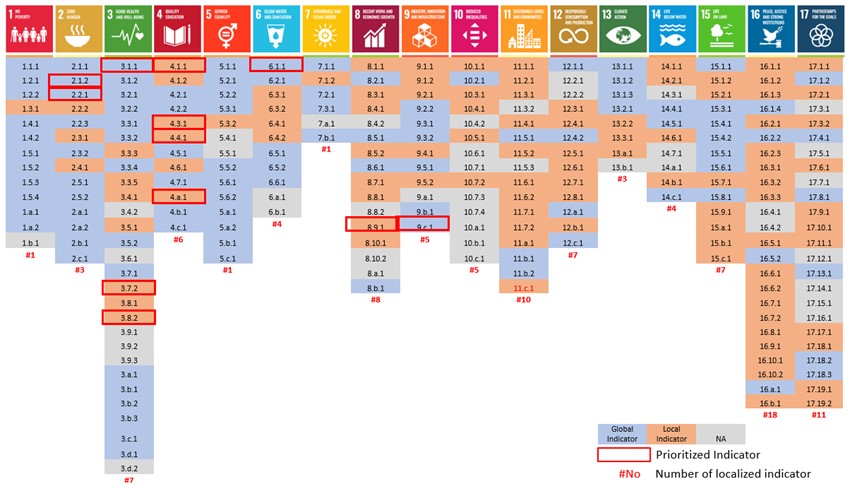Blog “Navigating the Understanding and Importance of SDG Localization”
2025.03.14
Researchers at the JICA Ogata Sadako Research Institute for Peace and Development (JICA Ogata Research Institute) have wide-ranging experience and diverse backgrounds, and they are forging partnerships with varied stakeholders and partners. This series of blog posts shares the knowledge and perspectives that they have acquired through their research activities. This post was written by Andi Besse Rimba, Research Fellow, who is working on Sustainable Development Goals (SDGs), and Climate Change Mitigation and Adaptation.
Author: Andi Besse Rimba, Research Fellow, JICA Ogata Research Institute
Reviewer: Sato Ichiro, Executive Senior Research Fellow, JICA Ogata Research Institute
SDG localization refers to adapting and applying the United Nations SDGs at the local level (national and subnational), ensuring that global objectives are translated into relevant and practical actions within specific local contexts (FAO and UNDP 2023). Global indicators often lack relevance when viewed through unique local contexts in various countries and regions. Regarding their localization at the city level, Japan has successfully adopted SDGs in local cities. Approximately 138 local governments in Japan (76% of all 182 local governments) utilize local indicators related to their unique initiatives (Endo 2025-Current study). Localization focuses on achieving the SDGs through local policy planning, governance, and community initiatives. Additionally, this ensures that the SDGs are more relevant and implementable by local governments and other stakeholders.
Localization is increasingly popular at the indicator level, as opposed to the target or goal level, because it allows for more accurate and contextualized insights for effective decision-making and the enforcement of policies. Localized indicators provide the more nuanced comprehension of regional disparities and needs often lost in generalized global metrics.
Benefits from the localization of the SDGs include precision in policy implementation, monitoring progress and tracking performance. They improve the achievement of targets by engaging national contexts relevant to practical implementation (Gao et al. 2017). They also empower nations to focus on specific sustainability goals/targets, such as food production, biodiversity, health, education, or land degradation, based on their unique needs and capabilities. SDG localization is important because it helps to monitor their progress over time and across different locations.
For example, Xu et al. (2020) conducted a study in China to demonstrate how spatiotemporal analysis can track progress across different regions. They found diverse SDG progress across various regions in China; for example, there were higher scores in Eastern China than in Western China in the 2000s and in Southern China than in Northern China in 2015. These differences highlight that regional variation needs to be factored into assessing SDG progress. Furthermore, by describing interactions amongst SDG targets, localization may underpin priorities for integrated policy so that interventions can be harmonious and mutually reinforcing (Nilsson et al. 2018).
Several examples of SDG localization in China, Norway, and Sweden show its benefits.
China: China has integrated the SDGs into its national development indicators, reflecting its unique socio-economic conditions by emphasizing system development and coordination, with regional differentiation in implementation. The results and impacts are positive overall trends in sustainable development, with Beijing and Shenzhen leading the way. However, regional disparities and declining system sustainability signal future challenges (Hu & Li 2023).
Norway: Norway focuses on coastal planning in Andoya regarding SDG localization strategy at the subnational level. Fuller et al. (2023) utilize Q-methodology to gather local perspectives and integrate the SDGs into existing policy processes. The results and impacts of localization have enhanced stakeholder engagement and social transformation, fostering human agency and capacities for sustainability.
Sweden: Sweden has developed a multi-actor platform for SDG implementation at the country level using cross-sectoral collaboration and leadership. The results and impacts of early-stage collaboration highlighted the importance of understanding organizational ambitions and roles, though challenges in leadership neutrality have been noted (Krantz and Gustafsson 2023).
At the JICA Ogata Research Institute we are undertaking a case study on this topic in Indonesia. In this study, the importance of the SDGs indicators is measured using statistical data at the provincial level in Indonesia and Network Analysis. Network analysis offers a robust framework for prioritizing the SDG indicators by examining their interlinkages and systemic importance. This approach uses their interconnected nature to identify which goals or targets should be prioritized to have the most significant impact. Hence, the study is exploring the quantification of the interaction between indicators, identifying the priority indicators, and developing evidence-based policy guidance.
Next, the proposed priority indicators from Network Analysis (indicators framed in red in Figure 1) have been examined to find how many of them are localized indicators of Indonesian SDGs at the provincial level. Figure 1 shows that out of the 12 prioritized indicators, 7 were localized indicators. This seems to indicate that most of the prioritized indicators have been tailored according to the needs and particularities of local contexts, underlining the importance and efficiency of indicator localization regarding monitoring the progress of the SDGs.

Figure 1. Total number of global indicators, localized indicators, and prioritized indicators (Source: Author).
Even though there are some successful stories of localization, it still faces several challenges mainly due to the complexity of translating global targets into actionable national and subnational strategies. Furthermore, other challenges may derive from inequalities in data availability, governance structures, and socio-economic conditions across regions. The absence of data means challenges for the achievement and tracking of the SDGs. Most local governments lack the resources and data to implement and monitor them closely, which becomes a barrier to progress given the risk of ineffective localization efforts (Leavesley et al. 2022). Moreover, the lack of information can also result in inconsistent and poorly communicated efforts (Mortimer et al. 2023).
Other challenges are the diverse and context-specific nature of local environments. These limitations can make the effective implementation of the SDGs at the local level problematic, as global strategies do not always match local needs and capacities. Hence, implementation of the SDGs locally, as global strategies may not always align with local needs and capacities. Localities often face unique challenges that make generalized SDG strategies impractical. The specific geographical, social, and policy environments require tailored approaches that are not always feasible with the current global SDG frameworks (Tan et al. 2019).
This blog is part of the “Study on the Indicator Framework for Post-2030 International Development Goals
” research project. The next step of this study is to determine how to prioritize SDG indicators at the local level in a developing country and how localization will influence the priorities of the sustainable development agenda after 2030.
Endo, Kei, (2025). “SDGsローカル指標に係る研究:日本の自治体の取組み”
FAO-UNDP. (2023). SDG Localization in Europe and Central Asia – Guidelines to Support Subnational Development Planning and Budgeting.
https://doi.org/10.4060/cc8164en
Fuller, Jessica L., Ingrid van Putten, Marloes Kraan, Maiken Bjørkan, and Dorothy J. Dankel. (2023). “'Sustainability Is Not a Vegan Coffee Shop.' Eliciting Citizen Attitudes and Perspectives to Localize the Un Sustainable Development Goals." Journal of Environmental Planning and Management 67, (14): 3480-501. https://doi.org/10.1080/09640568.2023.2223761
.
Gao, Lei, and Brett A. Bryan. "Finding Pathways to National-Scale Land-Sector Sustainability." (2017). Nature 544(7649): 217-22. https://doi.org/10.1038/nature21694
.
Hu, Zhigao, Qi Wu, and Jing Li. (2023). "The Localization of SDGs in China: System Construction, Status Assessment and Development Reflection." Ecological Indicators 154: 110514. https://doi.org/https://doi.org/10.1016/j.ecolind.2023.110514
. https://www.sciencedirect.com/science/article/pii/S1470160X23006568
.
Krantz, Venus, and Sara Gustafsson. (2023). "Regional Collaboration for the Sustainable Development Goals: Experiences from Developing a Multi‐Actor Platform in Sweden." Sustainable Development 31(6): 4007-18. https://doi.org/10.1002/sd.2580
.
Leavesley, A., A. Trundle, and C. Oke. (2022). "Cities and the Sdgs: Realities and Possibilities of Local Engagement in Global Frameworks." Ambio 51(6)): 1416-32. https://doi.org/10.1007/s13280-022-01714-2
. https://www.ncbi.nlm.nih.gov/pubmed/35244894
.
Mortimer, Anastasia, Iftekhar Ahmed, Thomas Johnson, Liyaning Tang, and Margaret Alston. (2023). "Localizing Sustainable Development Goal 13 on Climate Action to Build Local Resilience to Floods in the Hunter Valley: A Literature Review." Sustainability 15, (6). https://doi.org/10.3390/su15065565
.
Nilsson, M., E. Chisholm, D. Griggs, P. Howden-Chapman, D. McCollum, P. Messerli, B. Neumann, et al. (2018). "Mapping Interactions between the Sustainable Development Goals: Lessons Learned and Ways Forward." Sustainable Science 13(6): 1489-503. https://doi.org/10.1007/s11625-018-0604-z
. https://www.ncbi.nlm.nih.gov/pubmed/30546483
.
Tan, D. T., J. G. Siri, Y. Gong, B. Ong, S. C. Lim, B. H. MacGillivray, and T. Marsden. (2019). "Systems Approaches for Localizing the SDGs: Co-Production of Place-Based Case Studies." Global Health 15(1): 85. https://doi.org/10.1186/s12992-019-0527-1
. https://www.ncbi.nlm.nih.gov/pubmed/31847865
.
Xu, Zhenci, Sophia N. Chau, Xiuzhi Chen, Jian Zhang, Yingjie Li, Thomas Dietz, Jinyan Wang, et al. (2010). "Assessing Progress Towards Sustainable Development over Space and Time." Nature 577(7788): 74-78. https://doi.org/10.1038/s41586-019-1846-3
.
Disclaimer: All opinions expressed in this blog post are the author’s and do not reflect opinions of JICA or the JICA Ogata Research Institute.

事業事前評価表(地球規模課題対応国際科学技術協力(SATREPS)).国際協力機構 地球環境部 . 防災第一チーム. 1.案件名.国 名: フィリピン共和国.

事業事前評価表(地球規模課題対応国際科学技術協力(SATREPS)).国際協力機構 地球環境部 . 防災第一チーム. 1.案件名.国 名: フィリピン共和国.

事業事前評価表(地球規模課題対応国際科学技術協力(SATREPS)).国際協力機構 地球環境部 . 防災第一チーム. 1.案件名.国 名: フィリピン共和国.

事業事前評価表(地球規模課題対応国際科学技術協力(SATREPS)).国際協力機構 地球環境部 . 防災第一チーム. 1.案件名.国 名: フィリピン共和国.

事業事前評価表(地球規模課題対応国際科学技術協力(SATREPS)).国際協力機構 地球環境部 . 防災第一チーム. 1.案件名.国 名: フィリピン共和国.
scroll